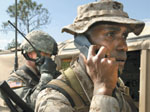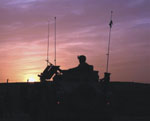New Wireless Rule Up in the Air
 |
| Commercial wireless networking technologies based on the 802.11n standard may provide warfighters in operation Iraqi Freedom with increased data throughput capabilities at longer ranges. |
The latest version of a widely used commercial communications standard may soon provide
A part of the
The 802.11n rule improves on previous standards by incorporating multiple-input multiple-output (MIMO) technology. MIMO relies on many transmitter and receiver antennas to provide increased data throughput by spatial multiplexing. Increased wireless network ranges take advantage of the spatial diversity that multiple antennas and software coding techniques create. When approved, the 802.11n amendment will follow the 802.11a/b/g wireless networking rules.
However, the IEEE committee rejected the most recently proposed version of the standard, says Ken Dulaney, an analyst with Gartner Incorporated,
Although the current 802.11n standard is being revised, Dulaney explains that the core of the rule is well established. The difficulty lies with selecting the most efficient form of MIMO technology. For example, the transmit and receive MIMO is easier to manage because it requires multiple antennas and multipath systems. The other competing technology is transmit MIMO, a more challenging technology because it proactively creates the system by sending signals out through different paths and then reassembling them at the receiving end. “By forcing it out that way, you’re going to potentially have less randomness of the signal at the other end. You will recover more of the bits without error correction,” he says.
The 802.11n standard will allow users to optimize their systems for either speed or distance, but like all radio communications systems, the tradeoff is between high data speeds and increased range. “When you transmit a whole lot of bits as fast as you can through the air, it’s only going to work at a certain distance where the interference from the surrounding airspace is not going to corrupt the data all that much. As you start to lengthen that, if your throughput rate is lowered, you can leave longer spaces between the errors—you can absorb more errors and get the additional distance at the sacrifice of speed,” he says.
The U.S. Army is interested in using 802.11-based wireless networking technologies to meet some of its battlefield communications requirements. According to John H. Shipp, director, Technical Architecture Division, Army Chief Information Office/G-6 (CIO/G-6),
Dulaney also is critical of vendors’ prematurely labeling their applications as 802.11n compliant. He notes that many of these manufacturers were embarrassed when the recent draft of the standard was rejected. “You can look at these technologies for what they’re worth, but believing that they are in any way related to the standard is wrong because compliance with the standard would imply interoperability or upgradability to some degree. You’re never going to see that with these pre-draft vendors. You can buy [them] for their technology, and there might be some reason to do that. But to buy them for interoperability with other vendors would be a serious mistake,” he maintains.
To compare MIMO technology with other Wi-Fi applications, users must understand the tradeoffs associated with increased capability. Shipp notes that MIMO requires more complex signal processing capabilities than 802.11a/b/g. The 802.11a standard operates in a different frequency band than 802.11b/g/n, so these three frequencies enjoy better signal propagation.
An ongoing debate also is taking place about how wide an 802.11n channel band can be. Shipp explains that 802.11a/b/g have 20-megahertz channel bands, whereas some vendors have incorporated 40-megahertz bands within their 802.11n product lines. The added bandwidth directly increases overall throughput, but at the price of using additional spectrum.
Shipp believes that the 802.11n’s MIMO technology could increase capacity for other waveform applications. He shares that the Defense Advanced Research Projects Agency and the U.S. Army Communications– Electronics Research Development and Engineering Center (CERDEC) have formed a partnership to develop mobile MIMO technology. Providing a mobile capability is more suitable for a military environment because the propagation and processing complexity of current MIMO standards require both the subscriber station and the base station to remain stationary. But he cautions that there is no silver bullet when using a single waveform as an end-to-end solution. “Each technology can be used optimally at one location in a system architecture while it can be deficient at another location in the same architecture,” he shares.
Higher throughput and range are key priorities when communications systems are developed. Shipp notes that increased data rates allow developers to create applications that can take advantage of the additional throughput and that the greater capability often enhances a new software feature that would have been hindered by bandwidth constraints.
 |
| The Army Warfighter Information Network–Tactical program is using 802.11-based technology for its vehicle-to-vehicle communications system. |
But few Army programs of record currently use any of the 802.11 standards as a core program baseline. The most notable exception is the Warfighter Information Network–Tactical (WIN-T) program, which uses the 802.11 and 802.16 standards as part of its vehicle-to-vehicle communications systems in addition to its high band networking waveform and satellite communications waveform. Shipp says that the Army’s CIO/G-6 has recently purchased Harris manufactured SECNET 11 and SECNET 54 devices that are built to the 802.11b and 802.11g standards. Leveraging commercial standards in these applications reduces cost while adding security that meets National Security Agency standards. He explains that current architectures are incorporating these 802.11-based technologies to provide secure wireless environments in tactical operations centers.
CERDEC engineers also are participating in IEEE standards committees to ensure that Army requirements are included in the approved amendment. “Providing the Army’s needs while the standards are being developed reduces the engineering required by vendors to adapt their products to meet military needs,” Shipp shares.
However, the Army does not currently have a formal program to use the 802.11 standards, although Shipp notes that the military is now emphasizing cost savings by using commercial waveforms. He adds that Army units in operational theaters are now acquiring 802.16 products to provide low-cost communications solutions for post, camp and station applications and that the service is constantly leveraging commercial technologies to meet its needs.
Neither the 802.11 or 802.16 communications standards are included in the Future Combat Systems (FCS) baseline, says Seth Spoenlein, a systems engineer with CERDEC’s systems engineering, architecture, modeling and simulation division in the Space and Terrestrial Communications Directorate,
Spoenlein notes that for FCS systems communicating with functionality comparable to 802.11n equipment, increased data throughput would improve local area network performance at the company level. At higher echelons, communications mostly will be carried out by other waveforms such as the wideband networking waveform. Although the FCS program is actively committed to JTRS and WIN-T, it is working across the U.S. Defense Department to incorporate emerging technologies into its family of systems. He adds that the program seeks to increase throughput performance at every functional node throughout its mission systems as those capabilities become available.
However, some caution is necessary when comparing data rates, throughput and ranges between current Army waveform initiatives and commercial standard protocols, Spoenlein says. The Army’s current strategy is to develop mobile ad hoc networking (MANET) waveforms for its future systems. MANET waveforms allow network architecture to be flexible enough to avoid requiring a single base station to distribute and control the network, which creates a single point of failure. But most commercial 802 standards being developed are designing their networks around a single fixed base station.
Spoenlein explains that the protocols in commercial 802 standards tend to limit overall user density while maintaining high user throughput. By having a fixed base station, the system can optimize its location to provide the best performance characteristics. The additional flexibility gained by MANET systems is traded for the increased overhead required to manage the system, he says. This additional overhead reduces end user throughput. “The Army’s requirements are much more stringent than typical consumer needs. The tactical military does not have the luxury of erecting high towers with a stationary base station during an engagement. The Army has requirements to pass classified data across its networks, and those networks must be secure to accommodate these needs,” he maintains.
Web Resources
IEEE: www.ieee.org
CERDEC: www.cerdec.army.mil




Comments